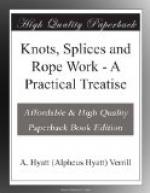When the rope-worker has mastered all the knots, ties, bends, hitches, and splices I have described, he will find a new field open to the use of rope in innumerable ways. Barrels, casks, bales, or other objects may be roped, or slung, with ease and security; ropes will be pressed into service for straps and belts; and buckles may be readily formed by the simple expedient shown in Fig. 144. If a swivel is required it can be arranged as shown in Fig. 145, while several simple slings are illustrated in Figs. 146-148. In a factory, or machine shop, rope belting will often prove far better than leather, and if well spliced together will run very smoothly and evenly even on long stretches. As a recreation for killing time aboard ship, or on rainy vacation days, few occupations will prove more enjoyable than tying fancy knots and making new splices and bends or inventing new variations of the numerous hitches, ties, and knots you already know.
[Illustration: FIG. 144.—Rope buckle.]
[Illustration: FIG. 145.—Swivels.]
[Illustration: FIG. 146]
[Illustration: FIG. 147]
[Illustration: FIG. 148]
[Illustration caption: FIGS. 146, 147, and 148.—Slings.]
HALTERS FOR ANIMALS
Every now and then a temporary halter is needed for a horse, and in Fig. 149 such a halter is shown. This halter is made by putting the end of a long rope around the neck of the horse and then tying a common bow-line knot. (See Fig. 150.) Fig. 151 shows the second step to be followed, that of passing the rope around the animal’s head twice, while Fig. 152 shows how the second loop is passed under the first. In Fig. 153 the rope is shown sufficiently long enough to enable it to be passed over the ears of the animal and leave the halter completed, as shown in Fig. 154.
[Illustration: FIG. 149—Put a Loop over the Horse’s Nose.]
[Illustration: FIG. 150—The “Bowline” Knot.]
[Illustration: FIG. 151—Follow this with a Second Loop.]
[Illustration: FIG. 152—Pass the Second Loop under the First.]
[Illustration: FIG. 153—The Second Loop should be Long.]
[Illustration: FIG. 154—It goes over the Forelock and Ears.]
INDEX
Artificial eye
Baggage
Barrels
Beams
Belaying-pin
Belaying-pin splice
Belting
Bends
Bight
Billet
Blackwall hitch
Blocks
Bolt-rope
Bow-knots
Bow-line
Bow-line on bight
Bow shortening
Boxes
Bridles
Builders’ hitch
Builders’ knot
Bundles
Butchers’ knots
Cable
Casks
Catspaws
Chain hitch
Chain knots
Chests
Cleat tie
Clinches
Close band
Clove hitch
Cordage
Core
Cotton
Cotton rope
Crown braid
Crowning
Crown knots
Cuckolds’ necks
Cut splice




